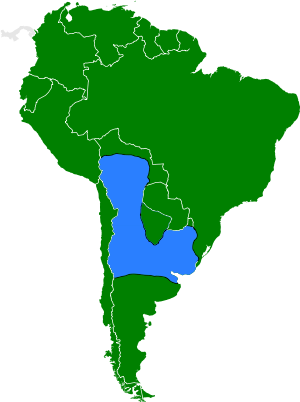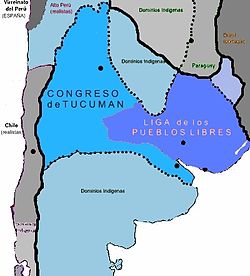- United Provinces of the Río de la Plata
-
United Provinces of the Río de la Plata
(United Provinces of South America)
Provincias Unidas del Río de la Plata
(Provincias Unidas en Sud-América)← 
1810–1831  →
→
 →
→
 →
→

Flag of the United Provinces, 1812 Coat of arms Anthem
Patriotic MarchUnited Provinces in 1816, during both the Independence War and the Civil War. In lighter blue, the territories not under Independentist control. In darker shades, the Supreme Directorship loyalist Provinces, and the Federal League Provinces. Capital Buenos Aires
(1810-1820)
(1826-1827)Language(s) Spanish Religion Christianity Government Republic Historical era Napoleonic Wars - British invasions of the Río de la Plata 1806-1807 - May Revolution 25 May, 1810 - Declaration of
Independence9 July 1816 - Battle of Cepeda
End of centralized authority1 February 1820 - First Presidency 8 February 1826 - Treaty of Montevideo
Independence of Uruguay28 August 1828 - Pacto Federal 4 January, 1831 Currency Real (since 1813)
Sol (since 1815)
Peso Fuerte (since 1826)The United Provinces of South America (Spanish: Provincias Unidas en Sud-América) was the original name of the state that emerged from the May Revolution and the early developments of the Argentine War of Independence. It comprised most of the former Viceroyalty of the Río de la Plata dependencies and had Buenos Aires as its capital.
It is best known, in Spanish literature, as Provincias Unidas del Río de la Plata (English: United Provinces of the Río de la Plata), this being the most common (occasionally the official) name in use for the country, until the enactment of the 1826 Constitution. Moreover, this is currently one of the official designations for Argentina, as stated in the Argentine Constitution, Article 35.[1]
Contents
Description
The United Provinces of South America was neighboured to the south by sparsely populated indigenous territories of Pampa and Patagonia which were the home of settled Amerindian nations such as the Mapuche, Ranquel and Puelche. To the north it was in contact with the indigenous territories of Gran Chaco populated by the Guaycuru nations. In the west was the Spanish controlled province of Chile and to the east was the Empire of Portugal.
Government
The change from the Viceroyalty into the United Provinces was not merely a change of governors, but a revolutionary process that would replace the absolutist monarchy with a Republic. The main influences in this were the Enlightenment in Spain, promoting new ideas, and the Peninsular War that left Spain without a legitimate King after the Abdications of Bayonne. The concept of separation of powers gradually became a tool to prevent despotism.[2]
The new political situation generated great political conflict between the cities for two reasons. First, the Vacatio Regis removed the sovereignty from the King of Spain, but there was no clear view about who and how would be able to claim such sovereignty. Some people thought that it passed to other offices of the Spanish monarchy, while others held the notion of the retroversion of the sovereignty to the people: sovereignty returned to the people, who had now the right to self-governance. The vertical organization of the absolutist monarchy was compromised as well. Patriots thought that all cities, both in Spain and in the Americas, had the right to self-government, whereas Royalists recognized that power only to European Spain, holding that the Americas should stay subject to the new government that Spain would provide.[3]
The other source of conflict was the nature of the new governments, which declared themselves to be provisional during the King's absence but were making strong changes in the political organization. Unlike the First Republic of Venezuela, which declared independence early on, the United Provinces were faced with the inconsistency of acting like an independent state without actually having declared such independence.
History
The United Provinces of the Río de la Plata were formally established in 1810, after the May Revolution. Buenos Aires, capital of the Viceroyalty of the Río de la Plata, ousted the Spanish viceroy Baltasar Hidalgo de Cisneros, and attempted to reorganize the political structure of the viceroyalty. The change was motivated by the Peninsular War in Spain, and the capture of the Spanish king Ferdinand VII.
However, not all the provinces shared the idea and opposed Buenos Aires, starting the Argentine War of Independence.
Ever since the foundation of the United Provinces, porteños (residents of Buenos Aires) attempted to assert control over the Union, trying to establish a unitary, centralist state, something which was opposed by the Federales, who created their own state, the Liga Federal, governed by federalist laws.
Liga Federal
Main articles: Liga Federal and Argentine Civil WarThe Liga Federal (1815–1820) or Liga de los Pueblos Libres (League of the Free Peoples) was a small nation in what is now Argentina and Uruguay that was created after the breakup of the Spanish Viceroyalty of the Río de la Plata. The idea of a federalist country originated from its leader, José Gervasio Artigas, a former officer in the Spanish army.
The government of the United Provinces of South America felt threatened by the Liga Federal, so they did nothing to repel the incoming Portuguese invasion of Misiones Orientales and the Banda Oriental. Brazilian General Carlos Frederico Lecor, thanks to their numerical and material superiority, defeated Artigas and his army and occupied Montevideo on January 20, 1817, but the struggle continued for three long years in the countryside. Infuriated by the passivity of Buenos Aires, Artigas declared war on Buenos Aires while he was losing to the Portuguese. On February 1, 1820, other leaders of the Federal League (Governor of Entre Ríos Francisco Ramírez and Governor of Santa Fe Estanislao López), defeatead the Supreme Directorship and ended the centralized government of the United Provinces, as they established a federal agreement with Buenos Aires Province.
As the United Provinces turned to a federal organization, the Federal League Provinces rejoined them and abandoned Artigas, who was expelled from the Banda Oriental by the Portuguese, and then exiled from Entre Ríos to Paraguay by his former ally Ramírez. The Eastern Province was annexed by Portugal to its Brazilian dependences in 1821.
Break up of the Viceroyalty of the Río de la Plata
 United Provinces represented at the 1813 Congress.
United Provinces represented at the 1813 Congress.
The result of the wars was the independence of the provinces:
Bolivia
Five provinces would go on to become Bolivia
- Charcas
- Cochabamba
- Mizque
- Chichas
- Tarija
Uruguay
The independence of the Eastern Province (Provincia Oriental) became Uruguay
Brazil
Misiones Orientales was awarded to Brazil, following the outcome of the Argentina-Brazil War.
Argentina
Following a long civil war, the following Provinces joined to become the Argentine Republic:
- Buenos Aires
- Entre Ríos
- Corrientes
- Santa Fe
- Mendoza
- San Juan
- Catamarca
- Tucumán
- Santiago del Estero
- Salta
- Jujuy
- Misiones
- Córdoba
- The outpost of Carmen de Patagones in Patagonia, part of Buenos Aires
Falkland Islands
Main article: Sovereignty of the Falkland IslandsThe United Provinces had intermittent control over the Falkland Islands, establishing a colony under Luis Vernet in 1829 despite British claims to the islands. The British regained control of the islands in 1833.
See also
- Origin and history of the name of Argentina
- Second Triumvirate (Argentina)
- Viceroyalty of Rio de la Plata
- Rise of the Republic of Argentina
References
- ^ "Art. 35.- Las denominaciones adoptadas sucesivamente desde 1810 hasta el presente, a saber: Provincias Unidas del Río de la Plata; República Argentina, Confederación Argentina, serán en adelante nombres oficiales indistintamente para la designación del Gobierno y territorio de las provincias, empleándose las palabras "Nación Argentina" en la formación y sanción de las leyes."
"Article 35 .- The denominations successively adopted from 1810 to the present, namely: United Provinces of the Río de la Plata, Argentine Republic, Argentine Confederation, shall henceforth be interchangeably official names to describe the Government and territory of the provinces, using the words "Argentine Nation" for the making and the enactment of laws." - ^ Ternavasio, p. 12
- ^ Ternavasio, p. 14
Bibliography
- Ternavasio, Marcela; Luis Alberto Romero (2007). Gobernar la Revolución. Buenos Aires: Siglo veintiuno editores. ISBN 978-987-1220-96-0.
- "Símbolos Nacionales de la República Argentina" ISBN 950-691-036-7
Argentine Civil War (1814-1876) Parties
involved
(leaders)Federalists (José Gervasio Artigas · Mariano Vera · Estanislao López · Francisco Ramírez · Juan Bautista Bustos · Manuel Dorrego · Facundo Quiroga · Alejandro Heredia · Pascual Echagüe · Juan Manuel de Rosas · Justo José de Urquiza · Ricardo López Jordán · Felipe Varela · Chacho Peñaloza)
Unitarians (Carlos María de Alvear · Juan Martín de Pueyrredón · José Rondeau · Bernardino Rivadavia · Juan Lavalle · José María Paz · Juan Esteban Pedernera · Gregorio Aráoz de Lamadrid · Pedro Ferré · Domingo Faustino Sarmiento)Battles Cepeda (1820) · Navarro (1828) · San Roque (1829) · Márquez Bridge (1829) · La Tablada (1829) · Oncativo (1830) · Sauce Grande (1840) · Famaillá (1841) · Caaguazú (1841) · Laguna Limpia (1846) · Vuelta de Obligado (1846) · Caseros (1852) · Don Gonzalo (1873)Treaties Pilar (1820) · Benegas (1820) · Quadrilateral (1822) · Cañuelas Pact (1829) · Federal Pact (1831) · Protocol of Palermo (1852) · San Nicolás (1852) · Pact of San José de Flores (1859)See also United Provinces of the Río de la Plata · League of the Free Peoples · Arequito Revolt · Revolution of the Restorers · Federal League · Unitarian League · Argentine Confederation · Uruguayan Civil War · State of Buenos Aires · Argentine Constitution of 1853Categories:- Former republics
- Former countries in South America
- Former confederations
- States and territories established in 1810
- States and territories disestablished in 1831
- 1830 disestablishments
- States and territories established in 1816
- Populated places established in 1816
- Argentine War of Independence
- History of Uruguay
Wikimedia Foundation. 2010.

